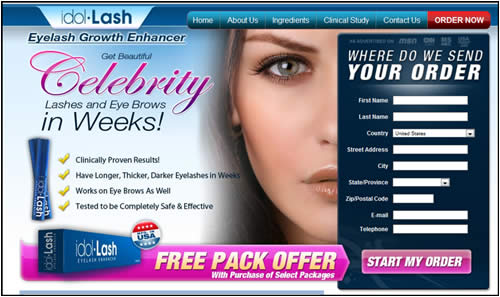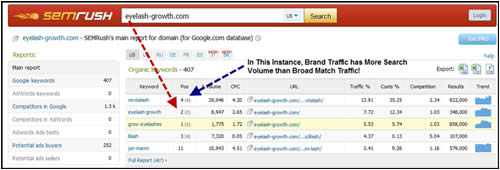For seasoned affiliates, there’s nothing revolutionary about the concept of targeting “brand traffic” or corralling “brand-driven searches” to send traffic to affiliate offers. While Pay Per Click Marketing has brand-name bidding limitations, SEO as a conversion mechanism (on the contrary) has promise.
The premise is simple; do you target “branded” or “broad traffic” for an organic SEO campaign? – and more importantly, why?
Picking the right keyword for your affiliate marketing campaigns can mean the difference between “zero traffic” or a scalable stream of relevant visitors perusing your offer.
On average, successful businesses spend anywhere from tens of thousands of dollars to millions of dollars annually to promote their branded keywords; this is free advertising and is a free traffic source to you, “if you can leverage those eyeballs”.
Unlike brief snippets from paid search advertisements, search engine optimization provides a more robust “editorial arena” that can yield a plentiful-harvest of freshly-squeezed conversions daily. While many mistakenly pursue broad-match or competitive keywords, there is another more-effective and simpler alternative you can easily implement in minutes.
Let’s start with an example such as “Idol Lash” which is an affiliate offer for “you guessed it” – a product that grows your eyelashes.

Idol Lash Brand-Rich Keywords
This tactic involves finding “brand specific” or “brand related keywords”, then optimizing them so your website can appear in the top 10 beside manufacturers for related keywords such as “reviews, comparison, buy, free trial, side effects” or other “buyer specific keywords”.
The advantage to this is simple, if you are an affiliate, you can leverage the power of their advertising and funnel visitors to your offers to facilitate conversion.
I do not condone cyber-squatting with exact match domains (which is unethical), but rather suggest broadening the net of targeting brand-specific keywords for landing page optimization.
Combine this simple keyword discovery process with powerful adjectives like, longer, darker, thicker and “action verbs” like get, find out, learn more, etc. – and you have some very compelling copy to put to good use.
This technique is simple and only takes a few minutes. First, you will need a membership to SEM Rush to find the keywords driving the most traffic to a website. Next, you will need to determine your offer, which angle to promote and what you are going to do with that traffic.
Often times, you can pass it along to the brand “with your affiliate link of course” and create a nice win/win relationship as a result of blanketing the SERPs (search engine result pages) with a conducive, yet appealing alternative slant of editorial appeal.
Getting Down to Business
Let’s review the tactic.
1. Find a “Buyer Keyword” that is qualified as a worthy target.
2. Identify the Criteria and Barrier to Entry.
3. Find your offer “how you will monetize that traffic” – this could go to the brand, or a competitor depending on your tact.
4. Create your Landing Page.
5. Optimize Your Keywords and Get Some Traffic.
Hypothetically, if I wanted to hone in and rank for keywords based around the context of the “Idol Lash” brand, nothing personal, just need something to showcase the tactic, I would execute the following steps:

1. Research the site using the brand name in SEM Rush, Google Wonder Wheel, Compete.com, Google Related Search and Google Instant “previewing suggested keywords” – for starters, to see what type of related searches, keyword modifiers and conversations are occurring semantically.
You can even use Google Insights or Google Trends to validate your keyword ideas to refine your keyword selection.
This allows you to log suggested synonyms or overlaps in relevance based on LARI (local aggregate relevance indicators). Then I would…
2. See if they are running any PPC Ads (if so, skim the copy for compelling keywords and take note for later).
3. After you find your seed set / fusion of keywords that have pull (reviews, buy, free trial, side effects, etc.), weave and integrate those modifiers into the offer or body copy of your page.
This will identify your landing page as part of “the authority set” meaning the highly qualified semantic counterparts of the keyword since search engines have also used those semantic cues to identify relevance for the keyword / brand – in their existing ranking algorithm.
4. Sign up for their affiliate program, set up your landing page, get some qualified links to it and, if the keyword is not extremely competitive, you should be able to rank within a few weeks and start tracking and refining your offers.
As an example, let’s say you used this technique and ranked on page one above the fold for “Idol Lash” like the affiliate website below. SEM Rush can reveal which keywords are actually providing the most click through traffic to the site and provide you with proven keywords to implement landing pages, A/B split testing and refinements to see which keyword represents the most opportunity for conversion.
Which Keyword Would You Rather Rank For?

*Brand Traffic In This Instance Has More Search Volume than Broad Keywords
In the image above, “Revitalash” (a branded keyword) in the #4 position drives 13.9% of the sites total traffic with over 29,946 searches per month for that keyword vs. the broad keyword “Eyelash Growth” in the #2 position that the domain’s URL is based on with it’s 7.72% of the total traffic with a mere 8,947 searches per month in comparison.
So, depending on the market, don’t look past brand-driven traffic as it is surprisingly less competitive than most broad match keywords. Another tip is to couple branded keywords with modifiers to create low-hanging-fruit, laser-targeted affiliate keywords using common sense and a few SEO tools.
While this example may have been overly obvious, surprisingly, in many markets, going after the brand terms organically, such as the name of the creator for a product – like “Tony Horton” instead of “P90X” can shave months or thousands of dollars off the time to rank for those keywords that are ripe with qualified traffic.



